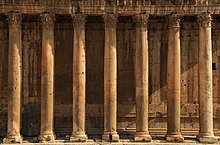
Back نظام كورنثي Arabic نظام كورنثى ARZ Korinf orderi Azerbaijani Карынфскі ордар Byelorussian Коринтски стил Bulgarian Korintski red BS Corinti Catalan Korintský řád Czech Коринф ордерӗ CV Korintisk orden Danish



The Corinthian order (Greek: Κορινθιακὸς ῥυθμός, Korinthiakós rythmós; Latin: Ordo Corinthius) is the last developed and most ornate of the three principal classical orders of Ancient Greek architecture and Roman architecture. The other two are the Doric order, which was the earliest, followed by the Ionic order. In Ancient Greek architecture, the Corinthian order follows the Ionic in almost all respects, other than the capitals of the columns, though this changed in Roman architecture.[1]
A Corinthian capital may be seen as an enriched development of the Ionic capital, though one may have to look closely at a Corinthian capital to see the Ionic volutes ("helices"), at the corners, perhaps reduced in size and importance, scrolling out above the two ranks of stylized acanthus leaves and stalks ("cauliculi" or caulicoles), eight in all, and to notice that smaller volutes scroll inwards to meet each other on each side. The leaves may be quite stiff, schematic and dry, or they may be extravagantly drilled and undercut, naturalistic and spiky. The flat abacus at the top of the capital has a concave curve on each face, and usually a single flower ("rosette") projecting from the leaves below overlaps it on each face.
When classical architecture was revived during the Renaissance, two more orders were added to the canon: the Tuscan order and the Composite order, known in Roman times, but regarded as a grand imperial variant of the Corinthian. The Corinthian has fluted columns and elaborate capitals decorated with acanthus leaves and scrolls. There are many variations.[2]
The name Corinthian is derived from the ancient Greek city of Corinth, although it was probably invented in Athens.[3]
- ^ Lawrence, 85; Summerson, 124, 176
- ^ "Corinthian Columns". Architect of the Capitol. Retrieved 2019-03-24.
- ^ Summerson, 124